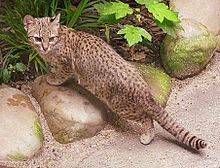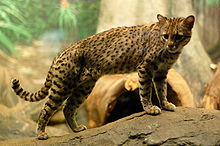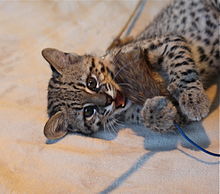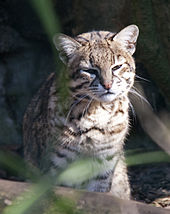- Geoffroy's Cat
-
Geoffroy's Cat[1] 
Conservation status Scientific classification Kingdom: Animalia Phylum: Chordata Class: Mammalia Order: Carnivora Family: Felidae Genus: Leopardus Species: L. geoffroyi Binomial name Leopardus geoffroyi
(d'Orbigny & Gervais, 1844)
Range of Leopardus geoffroyi Synonyms Oncifelis geoffroyi
Geoffroy's Cat (Leopardus geoffroyi) is a wild cat in the southern and central regions of South America. It is about the size of a domestic cat. While the species is relatively common in many areas, it is considered to be "Near Threatened" by IUCN because of concern over land-use changes in the regions where it lives. Large numbers of pelts were exported from South America for the international fur trade from the 1960s to 1980s, but little trade took place after 1988 and the species was upgraded to CITES Appendix I status in 1992 (Nowell and Jackson 1996). [3] International trade in Cites Appendix I listed species is prohibited, except for non-commercial purposes. [4]
Contents
Physical description
Geoffroy's Cats are about the size of a domestic cat, averaging 60 centimetres (24 in), with a relatively short, 31 centimetres (12 in), tail. They weigh only about 2 to 5 kilograms (4.4 to 11 lb), though individuals up to 7.8 kilograms (17 lb) have been reported. In general, those found in the southern part of their range are larger than those from the north, and males are larger than females.[5]
Their fur has numerous black spots, but the background colour varies from region to region: in the north, a brownish-yellow coat is most common; farther south, the coat is grayish. As with most cats, the fur of the underbelly is paler, being cream-colored or even white. There are dark bands on the tail and limbs, and similar markings on the cheeks and across the top of the head and neck. The backs of the ears are black, with a white spot. Melanism is common both in the wild and in captivity.[5]
Unusually among cats, Geoffroy's Cats have been observed to stand up on their hind legs to scan the surrounding landscape, using their tail as a support. A similar posture is seen in meerkats and prairie dogs, but not generally in other felines.[5]
Ecology and distribution
Geoffroy's Cats inhabit the Andes, Pampas (scrubby forest parts), and Gran Chaco landscape. They are found from southern Bolivia to the Straits of Magellan, at elevations ranging from sea level up to 3,300 metres (10,800 ft). They prefer open woodland or scrubland habitats with plenty of cover, but are also found in grasslands and marshy areas. Although they are able to climb trees, they rarely do so, except to leave faeces to scent mark their territory.[5]
Although it appears to be plentiful in central regions, including Bolivia, where it is the second most common cat after the ocelot, it is considered to be endangered in regions such as southern Chile.[2] The IUCN currently lists the species as "Near Threatened" because of the concern over habitat conversion in many countries in the cat's range. From the 1960s to the 1980s, Geoffroy's Cats were hunted extensively for their pelts.[6] Legislation introduced in the late 1980s made hunting and domestic trade of their pelts illegal in Argentina, Bolivia, Brazil, Chile, Paraguay, and Uruguay.
Geoffroy's Cat is nocturnal, and preys primarily on rodents, hares, small lizards, insects, and occasionally frogs and fish;[5] it is at the top of the food chain in its range. Like other small cats, it is a solitary hunter, regularly contacting others of its species only during the mating season. Females maintain territories ranging from 2 to 6 square kilometres (0.77 to 2.3 sq mi), while males have larger ranges, reaching up to 12 square kilometres (4.6 sq mi).[5]
Reproduction
The breeding season for Geoffroy's Cats lasts from October to March. During this time, the female comes into estrus for periods of up to twelve days, roughly a month apart. Mating during this time is brief and frequent, often taking place on a high ledge or similar site.[5]
Pregnant females appear to take extra care in choosing where they give birth to their kittens.[citation needed] Litters may consist of one to four kittens, although one or two is more common. Gestation lasts for 72–78 days,[7] with most births occurring between December and May.[6]
The kittens are born blind and helpless, weighing about 65 to 95 grams (2.3 to 3.4 oz), and develop rather more slowly than in the domestic cat. The eyes open after from eight to nineteen days, and they begin to eat solid food at six or seven weeks.[5] Kittens become independent of their mother at around eight months, but are generally not sexually mature until 18 months for females and 24 months for males. Geoffroy's Cats have been reported to live up to 14 years in captivity.[citation needed]
Recently, Geoffroy's Cat has been successfully bred with the domestic cat, resulting in the felid hybrid Safari Cat.[8]
Taxonomy
Geoffroy's Cat is named after the 19th century French zoologist Étienne Geoffroy Saint-Hilaire (1772–1844). Following his travels to South America in the early 19th century, Saint-Hilaire studied the cat while a professor of zoology in Paris, and identified five subspecies, based on geographic dispersement:[9]
- Leopardus geoffroyi geoffroyi; Central Argentina
- Leopardus geoffroyi euxantha; Northern Argentina, Western Bolivia
- Leopardus geoffroyi leucobapta; Patagonia
- Leopardus geoffroyi paraguae; Paraguay, Southeastern Brazil, Uruguay, Northern Argentina
- Leopardus geoffroyi salinarum; Northwestern and Central Argentina
Genetic studies have shown that Geoffroy's Cat is most closely related to the kodkod.[10] At times it has been placed in the separate genus Oncifelis, together with the kodkod and colocolo, but it is now more commonly placed in Leopardus, a larger genus of small South American cats, which also includes the ocelot.
References
- ^ Wozencraft, W. Christopher (16 November 2005). "Order Carnivora (pp. 532-628)". In Wilson, Don E., and Reeder, DeeAnn M., eds. Mammal Species of the World: A Taxonomic and Geographic Reference (3rd ed.). Baltimore: Johns Hopkins University Press, 2 vols. (2142 pp.). pp. 538. ISBN 978-0-8018-8221-0. OCLC 62265494. http://www.bucknell.edu/msw3.
- ^ a b Lucherini, M., de Oliveira, T. & Acosta, G. (2008). Oncifelis geoffroyi. In: IUCN 2008. IUCN Red List of Threatened Species. Downloaded on 22 march 2009. Database entry includes justification for why this species is near threatened
- ^ http://www.iucnredlist.org/apps/redlist/details/15310/0
- ^ http://www.cites.org/eng/app/appendices.php
- ^ a b c d e f g h Sunquist, Mel; Sunquist, Fiona (2002). Wild cats of the World. Chicago: University of Chicago Press. pp. 205–210. ISBN 0-226-77999-8.
- ^ a b Nowell, K. and Jackson, P. eds. (1996). Wild Cats. Status Survey and Conservation Action Plan. IUCN/SSC Cat Specialist Group. IUCN, Gland, Switzerland.
- ^ "Geoffroy's Cat". Indian Tiger Welfare Society. http://www.indiantiger.org/wild-cats/geoffreys-cat.html. Retrieved 2009-05-16.
- ^ http://www.savannahcatbreed.com/breed-info/safari
- ^ http://web.archive.org/web/20090104172437/http://www.lioncrusher.com/animal.asp?animal=51
- ^ Pecon-Slattery, J.W., et. al. (1994). "Phylogenetic reconstruction of South American felids defined by protein electrophoresis". Journal of Molecular Evolution 39 (3): 296–305. doi:10.1007/BF00160153. PMID 7932791. http://www.springerlink.com/content/u6588l0l8n333q86/?p=1c3f1eb64cea4b21971e29e2e39fe661&pi=7.
Categories:- IUCN Red List near threatened species
- Leopardus
- Animals described in 1844
- Mammals of Patagonia
- Mammals of Argentina
- Mammals of Bolivia
- Mammals of Chile
- Mammals of Paraguay
- Mammals of Peru
- Mammals of Uruguay
Wikimedia Foundation. 2010.




